Protimeter MMS2, Protimeter Moisture Meters
Protimeter MMS2 – the moisture meter you can operate with just one hand
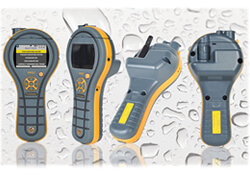 The new MMS2 represents the latest Protimeter technology in one intuitive, robust and fully functional design. If you’re surveying buildings, inspecting a home, drying a building after a flood, or testing concrete moisture for a flooring application, the MMS2 is the solution for you.
The new MMS2 represents the latest Protimeter technology in one intuitive, robust and fully functional design. If you’re surveying buildings, inspecting a home, drying a building after a flood, or testing concrete moisture for a flooring application, the MMS2 is the solution for you.
The Protimeter MMS2, is a 4-in-1 instrument, ergonomically designed for easy one-handed operation in measuring moisture in materials in buildings and related structures. It can measure surface moisture and moisture below a surface, as well as acting as a hygrometer to measure ambient air humidity.
The addition of an infra-red thermometer allows the difference between dew point and surface temperature to be calculated, as well as a wide range of other important psychometric parameters.
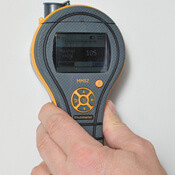 Search Mode (Non-Invasive Mode)
Search Mode (Non-Invasive Mode)
The Search mode detects sub-surface moisture, in relative terms, to a nominal depth of ¾” (20mm) in a wide range of solid building materials. It is a very quick and efficient method for assessing the moisture condition without damaging the surface. The Search mode is especially suited to finding moisture behind surface finishes such as vinyl and ceramic tiles.
The flat sensor on the underside of the instrument is held against the wall or floor to obtain a relative reading. Surface moisture does not adversely affect the Search mode reading, so the user can often distinguish sub-surface moisture from surface moisture when using both Search and Measure modes.
The readings are displayed numerically together with a colour coded progress bar for ease of interpretation. Green denotes safe air-dry, yellow denotes borderline and red denotes damp conditions. Readings can be stored in the instrument’s memory by pressing the ON button. If quantitative measurements are required, then Measure mode readings
should also be taken, as detailed below.
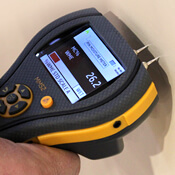 Measure Mode (Pin Mode)
Measure Mode (Pin Mode)
Pin mode measures the actual percent moisture content in wood or the percent Wood Moisture Equivalent (%WME) in a wide range of building materials. Pin mode gives the most reliable measurement of the moisture condition at the surface. Sub-surface WME measurements can be obtained by using the Deep Wall Probes, but this requires the drilling of clearance holes. Deep Wall Probes are often used to quantify (in WME) relative readings obtained in the search mode.
WME values in the range 6-99% are displayed numerically together with a colour coded progress bar for ease of interpretation. Green denotes safe air-dry, yellow denotes borderline and red denotes damp conditions.
The Protimeter MMS2 has integral pins located at the top of the meter under a protective cap. When required, Deep Wall Probes are connected via a side port. WME measurements can be stored in the instrument’s memory by pressing the ON button.
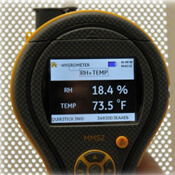 Hygrometer Mode
Hygrometer Mode
The Protimeter MMS2 is supplied with a compact thermohygrometer sensor, the Short QuikStick. This sensor is removable and interchangeable, but is usually left in position constantly for convenience. The Short QuikStick measures from 0-100%rh and 0-50°C/32-122°F. Standard Protimeter QuikStick and Hygrostick sensors can also be used with the Protimeter MMS2 for specialist humidity measurement applications, such as measuring the Equilibrium Relative Humidity value of a concrete floor in accordance with relevant standards.
Whatever thermohygrometer probe is used, the MMS2 calculates and displays the dew point temperature, which is essential for condensation risk assessment. When the psychometric function is selected, the prevailing specific humidity, dew point and vapour pressure values can be displayed, all useful measurements for HVAQ applications.
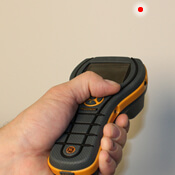 Remote Surface Temperature Measurement
Remote Surface Temperature Measurement
The MMS2 has an infra-red sensor built into the top of the instrument for non-contact surface temperature measurement. An integrated laser pointer indicates the position of the temperature measurement for clarity. The surface temperature is displayed together with the prevailing dew point temperature and the difference between the surface and dew point temperatures. So, at a glance, the user can assess the risk of surface condensation occurring or can confirm that condensation is occurring.
The distance to spot ratio is 12:1, making the MMS2 very practical for measuring the temperature of a ceiling when standing on the floor; no need for a step ladder. An optional plug in surface temperature probe can be used for applications that require more precise and accurate surface temperature measurement.
Operating the MMS2
The Protimeter MMS2 has an extremely easy to use and intuitive interface. Use the directional keys to navigate the simple menu to find the function or setting you need. The colour display is easy to see in low light and the use of the colour warning system means that the user can quickly determine the conditions of the atmosphere or material. Within the menu you will also find settings for metric and non-metric, auto off timer as well as set up features such as data logging. The new Protimeter MMS2 can store 8000 readings and download to your PC where the optional software will display them and graph the readings. As enhancements and new features are made available you will be able to upgrade the MMS2 firmware with a few simple mouse clicks.
Plug in Options
The Protimeter MMS2 comes with many options including choices of a hard carry case or a soft pouch. The different packages can be found on the datasheet. Plug options such as the remote moisture probe and hammer electrode shown in the demo can be purchased at the time you buy your MMS2 meter or at a later date. The hammer electrode is used to find moisture at different depths in timber and finished hardwood floors. Deep Wall Probes can be used to find moisture weep within the wall structure or cavity.
The newProtimeter MMS2 will help building professionals such as surveyors, inspectors and architects to assess building moisture levels during new build and refurbishing activities and assist in the diagnoses of moisture-related problems in existing buildings.